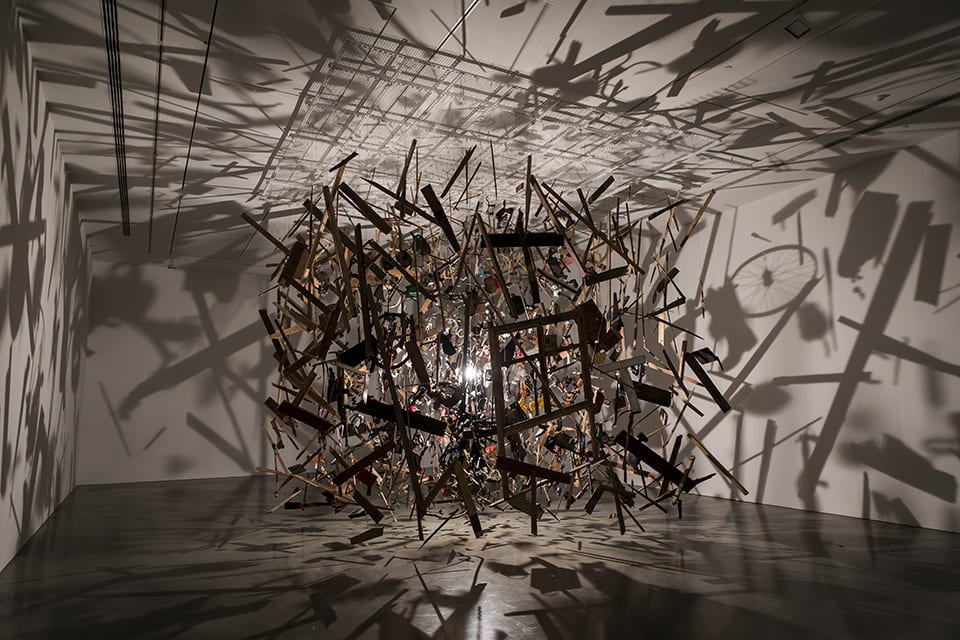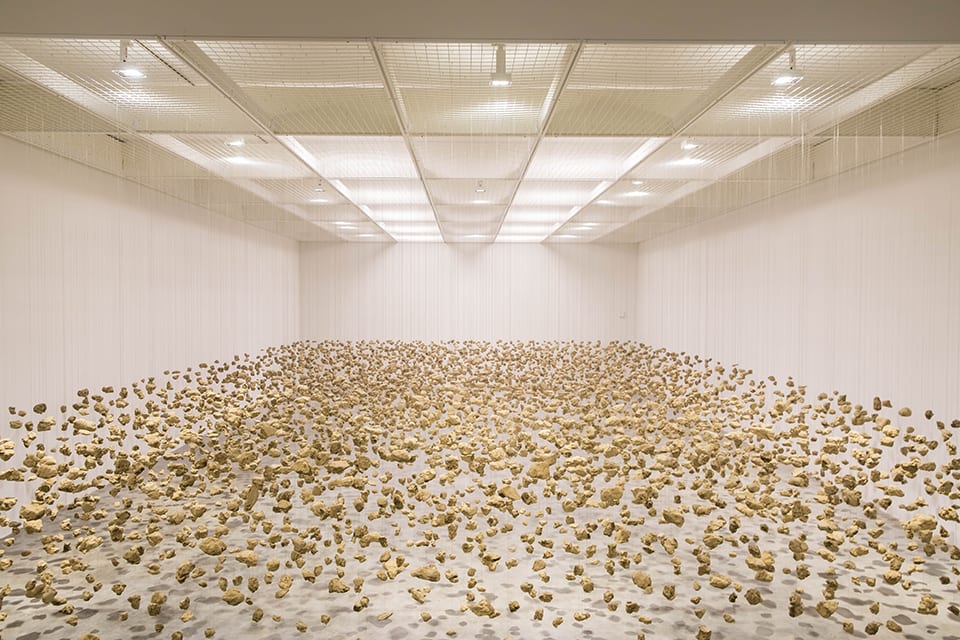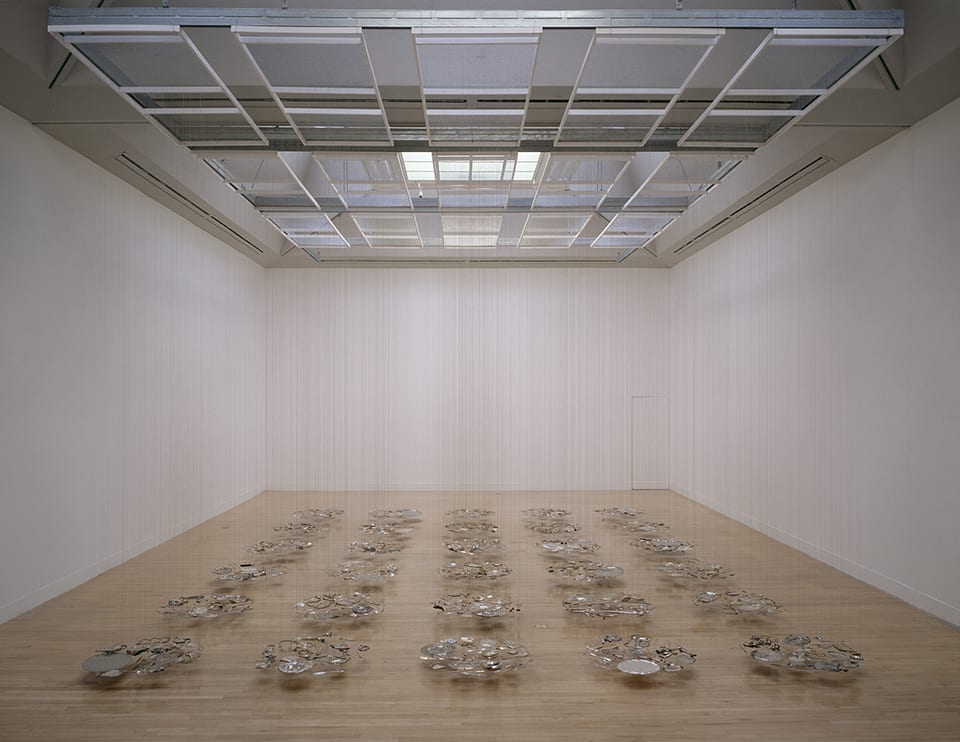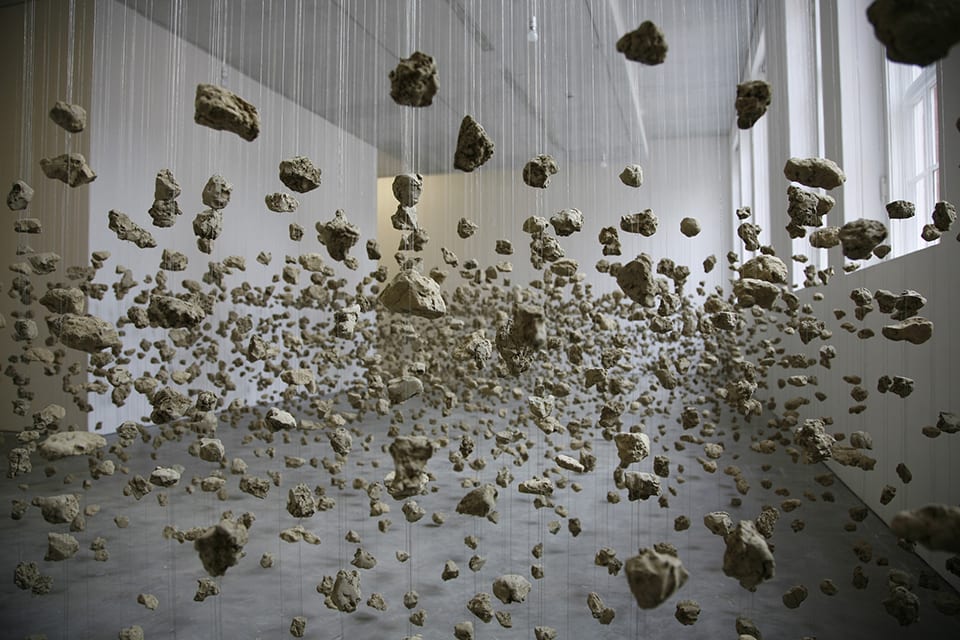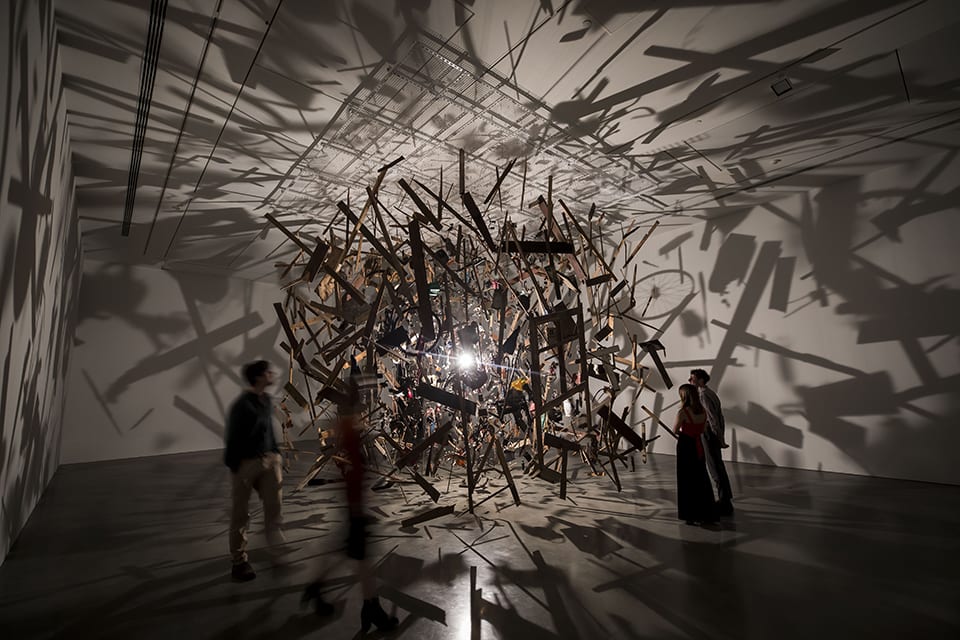Cornelia Parker has spent the last 40 years making ambitious installations that make sense of the volatile, violent and precarious world in which we live.
Cornelia Parker (b. 1956) is a professional agitator. A Turner Prize nominee and Officer of the Order of the British Empire, she has become world-renowned for dredging objects and ideas to the surface that many people would rather stay buried. Her pieces – which are realised through many mediums from sculpture and film to needlework – reflect on uncomfortable truths about the climate crisis, violence and freedom. She has relentlessly engaged with the world around her, wanting above all to be a “good citizen.”
The Museum of Contemporary Art Australia hosts her biggest retrospective to date as part of the 10th edition of the Sydney International Art Series. The exhibition encompasses over 40 artworks, some dating back to the 1980s. It becomes clear that although Parker has been working for over four decades – a time of mass cultural and technological change – her practice remains as prescient as ever. “Cornelia is an artist for this time. She has an uncanny ability to translate world events, big concepts and questions into works of art that are playful and reflective,” says MCA Chief Curator, Rachel Kent. “She alludes to things without being obvious, but they are of, and about, our time.”
“I think it’s very hard nowadays not to be political,” says Parker, speaking just a week after the UK general election results in December. Whilst she wasn’t the Official Artist this time round (she took the role in the 2017 snap election in which Theresa May won with the support of the DUP) she says she still has her “election artist hat on” when viewing the world around her. This, of course, is now intrinsically tied to the digital world. “I started using Instagram when I was the election artist. It was my first time using social media and I found it to be a really good tool to look at what’s happening around me,” she says. “I’m still looking through this lens; I’ve been looking through it for a long time.”
Parker thinks she has become more political as she has gotten older, and thus describes herself as an activist as well as an artist. “I’ve dragged my daughter to all these climate marches and I think what Extinction Rebellion is doing is great,” she says. ‘I’m part of Culture Declares – getting arts organisations to declare a climate emergency.” Parker had an awakening 12 years ago after attending a two-day event at Oxford University with climate scientists. “I came out completely changed,” she says. “What I was hearing was that we might not have a future unless we do something to mitigate what’s happening.” But, as Parker puts it, what role can art play when faced with melting ice caps and political inertia?
After that day in 2008, she made a film with Noam Chomsky, which is on show in Sydney. The 42-minute video, called Chomskian Abstract, shows Chomsky responding to questions posed by Parker. The questions have been edited out but the pauses where Chomsky listens were left in, offering a “silent space” for people to ask their own. It was recorded at a time when there was little mainstream discourse about the climate catastrophe and Chomsky’s clarity on the subject is chillingly prophetic. The film also answered Parker’s own doubts about the place of art in tackling this terrifying reality. Though the “powerful force of capitalism compels us to work ourselves to death in order to stuff our houses with things we don’t need”, Parker believes art can offer a new aesthetic of austerity; it can “imagine the unimaginable.”
Parker is adept at just this. Her large-scale installations explore growing political, societal and environmental concerns in ways that are hard to ignore. One seminal piece, Subconscious of a Monument (2001/2005), is composed of fragments of dry soil, which have been taken from underneath the Leaning Tower of Pisa by engineers in order to prevent its collapse. The lumps are suspended from wire and have filled gallery spaces and do so again at the MCA. The absurdity of removing the earth which supports one of our most iconic buildings speaks to the precariousness of our planet and the monuments we have created. We are burning through finite resources at an alarming rate. Our house is burning down, but we sit still in the centre.
Volatility is also an important theme in Parker’s work. It shows in the way the fragmented materials are suspended and displayed within the gallery space. “When you think about sculpture you might think about stone or bronze – things that are heavy and solid,” says Kent. “But for Cornelia, the works are the exact opposite; they’re airborne and light. It’s the way she sees the world: constantly changing and in a state of flux.” In the seminal piece, Cold Dark Matter: An Exploded View (1991) (which is regularly named by visitors as their favourite work in the Tate collection), she presents an exploded garden shed alongside its jumbled interior of household objects. It’s a visually arresting, highly dramatic display of domestic disorder, presenting homely nostalgia as a kind of perfect chaos. The shards are perpetually in a state of disarray – of violence and of extreme power.
“It’s like looking at the eye of the storm,” says Kent. “But you recognise all the things in the work; you see old fashioned curlers, garden equipment, children’s toys. They are things that we don’t want or need but we can’t get rid of.” To blow all this up is a radical act, like setting off a mine in the home and in doing so Parker is questioning this accumulation of stuff and the over-consumption that has led to it. These dramatic displays of what she terms “cartoon violence” have become synonymous with her practice: placing comedy amidst darker currents.
“It’s very powerful,” Parker says. “Look at Samuel Beckett; he deals with old age, death and the Stasi, and makes it hilarious. Having humour so close to pain and violence, having it cheek by jowl, is interesting.” In Thirty Pieces of Silver (1988/1989), a thousand silver objects – from teapots to trombones – have been ceremoniously steamrollered at Parker’s request. The number 30 is a reference to the amount Judas was paid to betray Christ. Alongside this biblical reference, the method in which the objects are prepared is a nod to the exaggerated violence of children’s cartoons and Carry On films. Ironically, the man who was hired to steamroll the silver featured in one of the movies.
Destruction – cartoon or not – is a recurring theme in Parker’s entire oeuvre. “People ask me: why is your work so violent? Why are there so many guns?” says Parker. “But I think explosions and guns are so ubiquitous in our world. They have an almost totemic status and I’m trying to unpick this to find out what that might be.” Her single sculptures are part of an ongoing series called Avoided Object, aptly named as they force viewers to face issues they would rather ignore. “I’m creating what Duchamp would call an ‘inframince’,” says Parker. “His would be the difference between a crumbled painting or one that is perfectly stretched – a small difference but it makes a big change. He’s somebody I’ve looked at a lot over the years.”
In a recent piece called Sawn Up Sawn Off Shotgun (2015) Parker presents the pieces of a sawn off shotgun that was used in a violent crime and later confiscated by the police. In a three-way collaboration between the criminal, the police and herself, she is presenting the object in an unexpected afterlife, its power deconstructed. Meanwhile, in Embryo Firearms (1995), she takes the embryos of Colt 45s guns before they have completed the production line, stopping them existing in the future as a gun. In Precipitated Gun (2015), the powdered residue of a firearm confiscated by the police and dissolved in acid by an engineer at the University of Manchester is presented as a line of rusty cocaine.
These unlikely collaborations have become a backbone of Parker’s practice. Working with other organisations began as a means of necessity; she called on expertise when she needed help blowing something up or flattening it. However, this grew into something much more methodical – actively seeking others out. “I began to think of other expertise I could call on, like the army,” she says. “I really like the idea of collaboration, it’s such fun – working with Customs and Excise, or the police – people who are really scary authoritarian figures. By working with them I feel less scared.”
For Magna Carta (An Embroidery) (2015) – arguably her most complex collaborative piece to date – she enlisted the help of over 200 people to create a tapestry of the Magna Carta Wikipedia page, 13 metres long. Prisoners, members of the judiciary, parliamentarians, MPs, journalists and activists all contributed to the work. Ever the anarchist, the work not only deconstructs the modern challenges to freedom and the rule of law, but also the nature of artistic authorship.
The question of autonomy also comes into play with the use of found objects. “She’s interested in the ready-made, like ordinary household objects,” says Kent. “She’ll often arrest these on their downward spiral; they’ve had pride of place in the home and now they’ve ended up in a garden shed or thrift store. She kills them off and resurrects them as works of art.” This cycle of birth, death and resurrection is a nod to her Catholic roots. By destroying and repurposing she gives objects multiple histories – a chance to start again.
Parker has been called an “ideas artist” but she puts it more plainly. “I keep thinking I’m like a grasshopper who jumps all over the place,” she says. “But I can’t help it, that’s just the way I’m built.” However, despite the visual diversity of her work, there is a consistent line of enquiry throughout. There’s a push and pull of opposite forces working in tandem, exaggerating and poking at each other: destruction and reconciliation, good and evil, death and rebirth.
Making these dual threads apparent was an important part of the curatorial process for Kent. “People ask me: how do you curate when she has done so many different things? But one of the joys is bringing it all together and showing this consistent trajectory,” she says. With that in mind, the show is not a chronological walk-through. Work is grouped in a way that enables conversations to arise between them. “People have had very strong, visceral reactions to the show,” adds Kent. “There is a sense of recognition through the display of objects from a bygone era that have been resurrected and given new life. They simultaneously touch on big concerns of our time. Some people said they felt like crying. It’s not sad work but it strikes a chord in people.”
Alexandra Genova
Cornelia Parker, MCA Sydney, until 16 February
mca.com.au

Cornelia Parker, Cold Dark Matter: An Exploded View, 1991. Installation view, Museum of Contemporary Art Australia, 2019. © The artist, photograph: Anna Kučera. 
Cornelia Parker, Subconscious of a Monument, 2001-05. Installation view, Museum of Contemporary Art Australia, 2019. © The artist, photograph: Anna Kučera. 
Cornelia Parker, Thirty Pieces of Silver, 1988-89. Image courtesy the artist and Tate. © Tate, 2019. 
Cornelia Parker, Subconscious of a Monument, 2001-05. Installation view, Ikon Gallery, Birmingham, 2007. © The artist. Photograph: Jerry Hardman-Jones. 
Cornelia Parker, Cold Dark Matter: An Exploded View, 1991. Installation view, Museum of Contemporary Art Australia, 2019. Image courtesy the artist, Museum of Contemporary Art Australia and Frith Street Gallery, London. Photograph: Anna Kučera.



